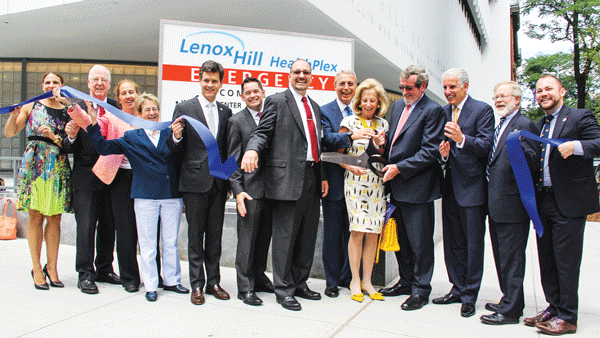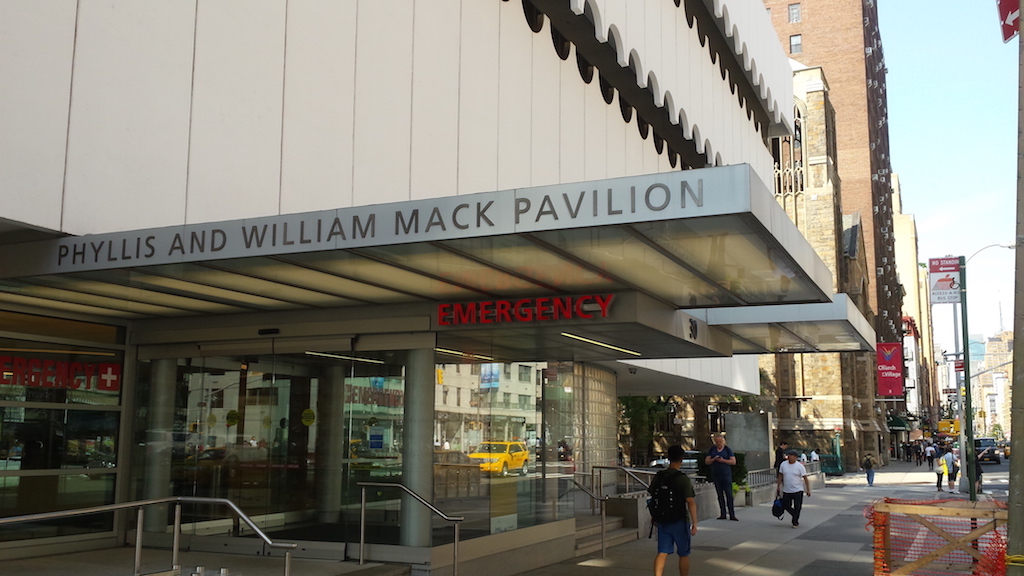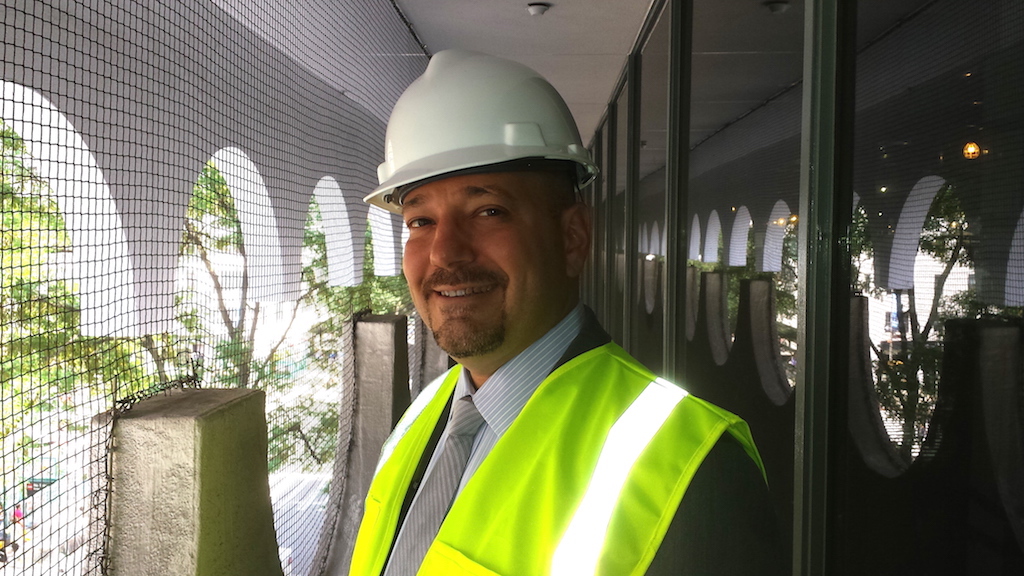
BY LINCOLN ANDERSON | Manhattan’s first freestanding emergency department, the recently renamed Lenox Health Greenwich Village, celebrated its one-year anniversary on Fri., July 17.
Four years after the bankrupt St. Vincent’s Hospital closed its doors, the Lenox Hill HealthPlex opened in the renovated former St. Vincent’s O’Toole Building, at W. 12th St. and Seventh Ave. In doing so, it returned healthcare to Greenwich Village and the Lower West Side.
Run by the North Shore-LIJ Health System, it’s called a freestanding or stand-alone E.D. because no inpatient hospital beds are attached to it. Patients needing higher-level care are transferred by ambulance to nearby area hospitals.
Resolving a legal dispute over the name “HealthPlex,” which is also used by a statewide dental plan, the facility was recently redubbed Lenox Health Greenwich Village. The lettering on the building’s exterior was recently taken down and the new signage will go up early next month.
Early on the afternoon of the anniversary date, Dr. Eric Cruzen, the director of emergency medicine at L.H.G.V., read off the latest figures on patient visits from a fresh computer printout.
As of 10 a.m. on July 17, the facility had treated a total of 28,912 patients — or an average of about 79 per day — over the past year. Lately, though, the numbers have been spiking, with the E.D. seeing more than 100 patients daily, and sometimes as many as 125 or 130.
“We presume it’s seasonal,” Cruzen said.
Also, he said, people are probably getting used to seeing the North Shore-LIJ ambulances in the neighborhood — two are based at the building — and at this point, there are likely repeat patients.
The vast majority of the patients are treated and released.
During the same one-year period, L.H.G.V. sent 2,052 patients — or 7.1 percent of people that entered for treatment — to local hospitals for higher-level care. Cruzen explained that it’s always “patient’s preference” in terms of what hospital they are taken to, though about two-thirds are taken to Lenox Hill Hospital on the Upper East Side, which is also part of NS-LIJ.
“Beth Israel gets the lion’s share of the rest of the transfers,” he noted.
In addition, in its first year, L.H.G.V. saw 1,300 pediatric patients, or about 5 percent of the total.
The patients are evenly divided between walk-ins and those brought by ambulance.

Cruzen is particularly proud of how the facility has performed in helping save patients suffering “STEMI” heart attacks, where there is blockage of blood flow to the heart. Over the past year, L.H.G.V. saw eight patients who were diagnosed with this condition.
“Most of the STEMI’s walked in with chest pain,” he said. “They were suffering a heart attack — and they had a 90-minute clock ticking.”
That’s the amount of time when heart muscle starts dying if there isn’t treatment with an angioplasty, a catheter balloon.
The guideline, the doctor explained, is “90 minutes from door to balloon inflation to open the artery.”
In all eight cases, the patients were sent to Beth Israel Hospital and the goal was met. Because these cases are so time sensitive, before L.H.G.V. opened, a special arrangement was worked out with Beth Israel so that the STEMI patients would be sent directly to the hospital’s cath lab, bypassing the B.I. emergency room.
The facility has also treated with good success, Cruzen said, about 10 patients who were suffering strokes, and in four of these cases administered an emergency clot-busting drug.
“I think when we first opened, people questioned how are we going to deal with strokes, heart attacks, traumatic head injuries,” said Alex Hellinger, the executive director of L.H.G.V.
Other conditions L.H.G.V. has treated include choking, asthma, sepsis, bowel obstructions and some women who walked in with obstetric emergencies and were transferred to Beth Israel and Lenox Hill.
“Ambulances don’t bring us third-trimester pregnancies, but they do walk in,” Cruzen noted.
And then there is always the fallout from the bars and clubs, such as sprained ankles and wrists, or worse.
“We have a good number of intoxicated patients with secondary injuries,” Cruzen explained, “due to our proximity to the Meatpacking District and the club and bar scene on the West Side…boozy brunches on Sundays.”
Hellinger added that usually patients are seen and treated much faster at the L.H.G.V. emergency department than at a crowded hospital emergency room. In addition, results from the facility’s basement lab — such as blood tests — come back much more quickly than they would in a hospital. And, unlike a hospital, there’s usually no, or minimal, waiting time to use a CAT scan or other imaging machines.
“It takes our CAT machine five seconds to scan a head to quickly rule if it’s a clot or a bleed,” he said of assessing stroke victims. “It’s a very, very different experience from a big E.R.,” he said of the overall feeling.
They see, on average, about one psychiatric patient a day, suffering conditions such as depression or suicidal thoughts. These are diagnosed remotely via a tele-link.
“It sounds a little out there, but it really works,” Cruzen said.
In the event of a blackout or major disaster, the building is outfitted with two rooftop emergency generators and a third can be hooked up outside. In the past year, the staff has done two simulated drills for chemical attacks, and recently did an Ebola-preparedness drill.

They’re anticipating steady growth in the volume of patients, though haven’t even done any advertising yet, mainly due to having to resolve the issue over the place’s name.
The freestanding E.D. has been built to accommodate up to 45,000 to 50,000 patient visits a year.
“That might not be next year, but might be where we land in the end,” Cruzen said. “Maybe we’ll get 36,000 next year.”
The E.D. is located on the building’s first floor, and there is the state-of-the-art full lab facility in the basement. Plans are underway to fill the rest of the building with other medical uses, making it even more of a healthcare hub.
Before Cruzen gave the update on the E.D., Hellinger gave The Villager a tour of the upstairs floors, which are in varying stages of construction.
The sixth floor, which is expected to open early next year, will be outfitted with 14 physicians’ offices / exam rooms. There will also be conference room space available to the community: The former main meeting room from when the building was a union hall will be renovated and open for community use, but will also be equipped to double as the L.H.G.V. command center in the event of major emergencies.
The fifth floor will have imaging services: MRI, CAT scans, ultrasound, X-rays and mammograms.
On the fourth floor will be four operating rooms and two procedure rooms for ambulatory surgery, including orthopedic surgery and neurosurgery, as well as pain management.
Designed by Albert Ledner, the distinctive white building was constructed in 1964 as the headquarters of the National Maritime Union. It was meant to resemble a ship floating on water, sporting porthole-style windows that also evoke waves.
Hellinger is especially proud of NS-LIJ’s renovation of the landmarked building.
“This neighborhood has such a rich culture and a rich history,” he said, “we want to make sure we’re in tune with that.”

From the start, L.H.G.V. has been receiving positive feedback from patients who have used the E.D.
“You know Village people,” said Cruzen, who also lives in the Village. “They walk right up to you and tell you what they think. They’re not shy, and I like that.”
Hellinger also personally gave a glowing report of how Cruzen recently diagnosed a condition he faced. He told the doctor he had been feeling pain in his side for years, and Cruzen, suspecting kidney stones, put him right on the CAT scan machine, which quickly proved him right. He indeed had several “huge” kidney stones.
Again, unlike a full-service hospital, there are no inpatient beds. (There are two beds, though these are just for patients, for example, who might need a brief recovery time.)
Could the Village emergency-care and healthcare facility ever be converted into a small yet full-service hospital?
“It’s not up to us,” Hellinger responded.
Indeed, the State Department of Health has to make the determination to authorize a hospital. And it was D.O.H. that, four years ago, quashed efforts to replace St. Vincent’s with a scaled-down full-service hospital.
“We’re focused on providing emergency care,” Cruzen said. “That’s what we’re built for. We want to be there for stubbed toes to heart attacks. The hospital bed upstairs doesn’t save your life. The emergency room saves your life.”
“I’ve seen them save lives,” Hellinger said. “I’m proud to be a part of it.”


































